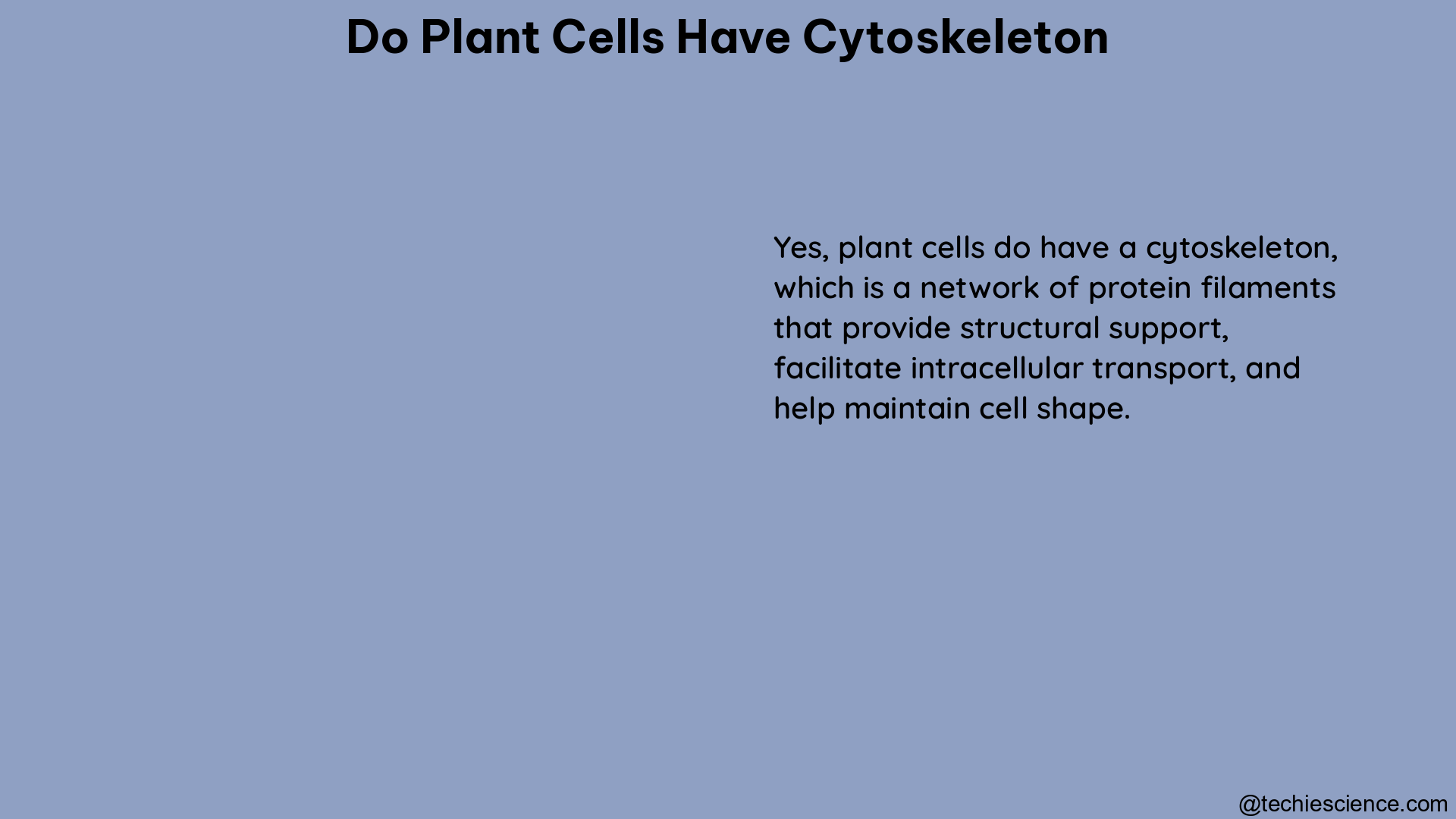Summary
Plant cells possess a dynamic and intricate cytoskeleton that plays a crucial role in maintaining cellular structure, facilitating intracellular transport, and coordinating various cellular processes. The plant cytoskeleton is primarily composed of two types of filamentous proteins: actin filaments (AFs) and microtubules (MTs), which undergo constant reorganization in response to both intracellular and extracellular cues. Quantitative analyses of the plant cytoskeleton have revealed its underlying organizational principles, which are essential for efficient transport within the cell. Advanced imaging techniques, such as total internal reflection fluorescence microscopy, have enabled researchers to study the fine details of the plant cytoskeleton, providing valuable insights into its structure and function.
The Composition of the Plant Cytoskeleton

The plant cytoskeleton is a complex network of filamentous proteins that provide structural support, maintain cell shape, and facilitate various cellular processes. It is primarily composed of two types of filaments:
-
Actin Filaments (AFs): Actin filaments are dynamic, thread-like structures that play a crucial role in cell motility, organelle movement, and cell division. They are composed of actin monomers that polymerize and depolymerize in response to various cellular signals.
-
Microtubules (MTs): Microtubules are hollow, cylindrical structures that are involved in the organization of the cell’s internal structure, the movement of organelles, and the separation of chromosomes during cell division. They are composed of tubulin dimers that assemble and disassemble in a highly regulated manner.
The plant cytoskeleton is highly dynamic, with AFs and MTs constantly undergoing reorganization in response to various intracellular and extracellular cues, such as hormones, environmental stresses, and developmental signals.
Organizational Principles of the Plant Cytoskeleton
Quantitative analyses of the plant cytoskeleton have revealed its underlying organizational principles, which are essential for efficient transport within the cell. These principles include:
-
Short Average Path Lengths: The plant cytoskeleton exhibits short average path lengths, which means that the distance between any two points within the network is relatively short. This property facilitates efficient intracellular transport, as cargo can be quickly and easily moved from one location to another.
-
High Robustness: The plant cytoskeleton is highly robust, meaning that it can maintain its overall structure and function even when individual components are disrupted or removed. This property ensures that the cell can continue to function effectively, even in the face of various stresses or perturbations.
-
Temporal Rearrangements: The plant cytoskeleton undergoes constant temporal rearrangements, with AFs and MTs constantly assembling, disassembling, and reorganizing in response to various cellular signals. These dynamic changes allow the cytoskeleton to adapt to the changing needs of the cell and support diverse transport processes.
Interestingly, the organizational principles observed in the plant cytoskeleton are similar to those found in man-made transportation networks, suggesting that there may be general laws of network organization that support efficient transport in diverse biological and engineered systems.
Advanced Imaging Techniques for Studying the Plant Cytoskeleton
Researchers have employed advanced imaging techniques to study the fine details of the plant cytoskeleton, particularly the cortical cytoskeleton (the cytoskeleton located near the cell membrane).
-
Total Internal Reflection Fluorescence (TIRF) Microscopy: TIRF microscopy is a powerful technique that can be used to visualize the cortical cytoskeleton with high resolution. By selectively illuminating a thin layer of the cell near the coverslip, TIRF microscopy can provide detailed information about the organization and dynamics of the cortical cytoskeleton.
-
Correlative Light and Electron Microscopy (CLEM): CLEM combines the advantages of light microscopy and electron microscopy, allowing researchers to study the plant cytoskeleton at multiple scales. This technique can provide information about the overall organization of the cytoskeleton, as well as the fine structural details of individual filaments.
-
Super-Resolution Microscopy: Techniques such as Structured Illumination Microscopy (SIM) and Stochastic Optical Reconstruction Microscopy (STORM) can achieve resolutions beyond the diffraction limit of light, enabling the visualization of the plant cytoskeleton at an unprecedented level of detail.
These advanced imaging techniques have been instrumental in improving our understanding of the plant cytoskeleton, its organization, and its dynamic behavior in response to various cellular signals and environmental cues.
Quantitative Modeling of the Plant Cytoskeleton
In addition to experimental studies, researchers have also employed quantitative modeling approaches to gain deeper insights into the plant cytoskeleton. These modeling efforts have focused on:
-
Network Reconstruction: By combining microscopy data with computational algorithms, researchers have been able to reconstruct the three-dimensional structure of the plant cytoskeleton, providing a detailed map of the filament organization within the cell.
-
Network Property Analysis: Researchers have analyzed the reconstructed cytoskeletal networks to identify the underlying organizational principles, such as short average path lengths and high robustness, that are essential for efficient transport within the cell.
-
Comparative Network Analysis: By comparing the reconstructed cytoskeletal networks to networks that optimize specific properties, researchers can gain insights into the evolutionarily shaped compromise between different network structures and their favored properties.
These quantitative modeling approaches, combined with advanced imaging techniques, have significantly advanced our understanding of the plant cytoskeleton and its role in supporting diverse cellular processes.
Conclusion
In summary, plant cells possess a dynamic and intricate cytoskeleton that is primarily composed of actin filaments and microtubules. Quantitative analyses of the plant cytoskeleton have revealed its underlying organizational principles, which are essential for efficient transport within the cell. Advanced imaging techniques, such as TIRF microscopy and super-resolution microscopy, have enabled researchers to study the fine details of the plant cytoskeleton, providing valuable insights into its structure and function. Additionally, quantitative modeling approaches have been instrumental in reconstructing the three-dimensional structure of the plant cytoskeleton and analyzing its organizational properties. These multifaceted research efforts have significantly advanced our understanding of the plant cytoskeleton and its crucial role in supporting the diverse cellular processes that are essential for plant growth, development, and adaptation.
References
- Breuer, D., Ivakov, A., Sampathkumar, A., Hollandt, F., Persson, S., Nikoloski, Z., & … (2014). Quantitative analyses of the plant cytoskeleton reveal underlying organizational principles. PloS one, 9(5), e97506.
- Colin, L., Martin-Arevalillo, R., Bovio, S., Bauer, A., Vernoux, T., Caillaud, M. C., … & Landrein, B. (2022). Imaging the living plant cell: From probes to quantification. The Plant Cell, 34(1), 247-272.
- Nikoloski, Z., Breuer, D., Hollandt, F., Ivakov, A., Persson, S., & Sampathkumar, A. (2015). Systems biology of plant cytoskeleton organization. Current opinion in plant biology, 25, 102-110.
- Sampathkumar, A., Ivakov, A., Hollandt, F., Persson, S., Breuer, D., & Nikoloski, Z. (2014). Quantitative modeling of the plant cytoskeleton: from microscopy images to systems biology. Journal of theoretical biology, 344, 12-24.

Hi…I am Arti Pandey, have a Master’s degree in Biotechnology. I am an academic writer in Lambdageeks and also a beginner Korean learner. I love to explore new cultures, places, and food. I love photography and had a keen interest in creative writing.